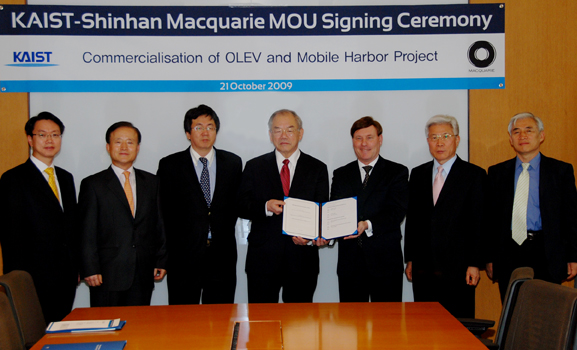policy
KAIST and Shinhan Macquarie Financial Advisory Co. have reached an agreement for cooperation in the development and commercialization of the KAIST-led two national green growth projects, On-line Electric Vehicle (OLEV) and Mobile Harbor (MH) programs, university authorities said.
KAIST President Nam-Pyo Suh signed a memorandum of understanding with John Walker, Chairman of Macquarie Group of Companies in Korea, and Woo-Gon Hwang, Representative Director of Shinhan Macquarie Financial Advisory Co. on Wednesday, Oct. 21.
Under the agreement, KAIST and Macquarie will cooperate in developing an optimal business structure for a rapid commercialization of OLEV and MH. Specifically, Shinhan Macquarie Financial Advisory will provide financial advice, including basis financial analysis, potential investor inducement and feasibility analysis of the projects.
Shinhan Macquarie Financial Advisory Co. is a joint venture between Shinhan Financial Group of Korea and the Australia-based Macquarie Bank Group which provides global investment banking and diversified financial services.
KAIST"s OLEV is a project to develop a new growth engine for Korea and lead the future of global automotive industry. It is an entirely new concept: the electric vehicle picks up power from underground power supplier lines, while either running or standing, through the non-contact magnetic charging method.
The MH program is designed to develop a system that can load/unload containers from a containership in the open sea and deliver them to their destinations at the harbor.
The Korean government has included these KAIST projects, which both are great technical and engineering challenges, in the nation"s sustainable growth programs, providing substantial research grants. KAIST offers its advanced research capabilities for the nation"s efforts to achieve efficient, environment-friendly utilization of resources as new growth engines that spur the development of related industries and explore global markets.

-
event KAIST School of Computing Unveils 'KRAFTON Building,' A Symbol of Collective Generosity
< (From the fifth from the left) Provost and Executive Vice President Gyun Min Lee, Auditor Eun Woo Lee, President Kwang-Hyung Lee, Dean of the School of Computing Seok-Young Ryu, former Krafton member and donor Woong-Hee Cho, Krafton Chairman Byung-Gyu Chang > KAIST announced on May 20th the completion of the expansion building for its School of Computing, the "KRAFTON Building." The project began in June 2021 with an ₩11 billion donation from KRAFTON and its employees, eventually gr
2025-05-21 -
event Life Springs at KAIST: A Tale of Two Special Campus Families
A Gift of Life on Teachers' Day: Baby Geese Born at KAIST Pond On Teachers' Day, a meaningful miracle of life arrived at the KAIST campus. A pair of geese gave birth to two goslings by the duck pond. < On Teachers' Day, a pair of geese and their goslings leisurely swim in the pond. > The baby goslings, covered in yellow down, began exploring the pond's edge, scurrying about, while their aunt geese steadfastly stood by. Their curious glances, watchful gazes, playful hops on water
2025-05-21 -
event KAIST Art Museum Showcases the Works of Van Gogh, Cy Twombly, and More at "The Vault of Masterpieces"
KAIST (President Kwang Hyung Lee) opened a special exhibition, "The Vault of Masterpieces", featuring the architects of the Gallerist Hong Gyu Shin, who is active in New York, on April 29th. Since its opening in December 2024, the KAIST Museum of Art, which has mainly exhibited works from its own collection, has boldly invited internationally renowned Gallerist Shin Hong-gyu to hold its first full-scale special exhibition, displaying a large number of his collections in the center of the camp
2025-04-30 -
event Formosa Group of Taiwan to Establish Bio R&D Center at KAIST Investing 12.5 M USD
KAIST (President Kwang-Hyung Lee) announced on February 17th that it signed an agreement for cooperation in the bio-medical field with Formosa Group, one of the three largest companies in Taiwan. < Formosa Group Chairman Sandy Wang and KAIST President Kwang-Hyung Lee at the signing ceremony > Formosa Group Executive Committee member and Chairman Sandy Wang, who leads the group's bio and eco-friendly energy sectors, decided to establish a bio-medical research center within KAIST and i
2025-02-17 -
research KAIST Develops Wearable Carbon Dioxide Sensor to Enable Real-time Apnea Diagnosis
- Professor Seunghyup Yoo’s research team of the School of Electrical Engineering developed an ultralow-power carbon dioxide (CO2) sensor using a flexible and thin organic photodiode, and succeeded in real-time breathing monitoring by attaching it to a commercial mask - Wearable devices with features such as low power, high stability, and flexibility can be utilized for early diagnosis of various diseases such as chronic obstructive pulmonary disease and sleep apnea < Photo 1. Fro
2025-02-13